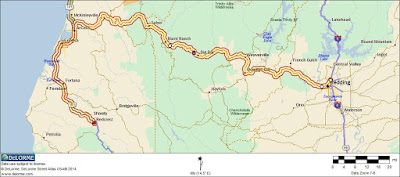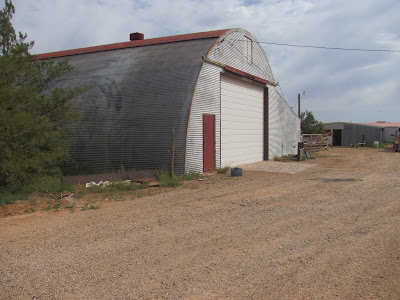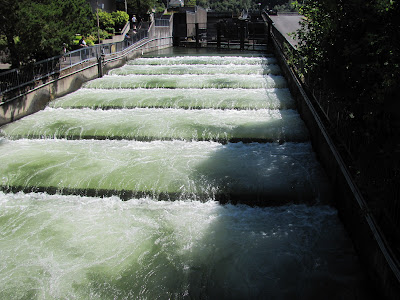After much work, our motor home is packed and ready to go. I will be towing our new Jeep Grand Cherokee this year. It will give us much more room for passengers and items in the back.
We will work our way across Texas, ever heading north, seeking the cooler weather. We are planning on driving approx 300 miles per day, with day off, for the 10 - 11 days it will take to get there. Our site seeing will be mostly in the west.
Driving day 1
We stayed in Alvord, Texas our first night. A +RV Park. A very simple RV Park, but conveniently placed on US 287 and had strong 50 amp service and a fast Verizon WIFI connection. Good for an overnight stop.
Driving day 2
Our next stop was in Amarillo, Texas at the Oasis RV Park on I-40. A nice RV Park, again located close to the freeway for easy access. We stayed in site 16 while our traveling partners used site 15. We were so tired when we arrived, a quick vote sent us into town to eat at the Hofbrau streak house for a center cut steak....
 |
| Alvord, Texas to Amarillo, Texas |
 |
| Albuquerque, NM, American RV Park, site 220 |
Driving day 3
We continued our journey to Albuquerque, NM, with a much needed rest stop. We stayed at American RV Park. It is a nice park located on the west side of Albuquerque. We stayed in site 220. It rained both days we were there. The cool temperatures were great.
Tomorrow morning,(in the rain) we head out for Cortez, Colorado. A small town in southwestern Colorado. It has a KOA, not fancy (gravel/dirt parking) but an overnight stop on our way to Salt Lake City.
We continue to work our way across the USA heading toward the northwest Pacific Coast
 |
| Lee, standing at the entrance door of the coach Cortez, Colorado. |
Driving day 4
Our destination of Cortez was achieved. Weather was cool (65) and the site was had came with a suburb view. We ate dinner in a small Mexican restaurant in town after a happy hour of sitting outside in the cool air. We made plans for our next segment of the drive and had a drivers meeting in the morning.
Heading to Salt Lake City, Utah.
 |
| Albuquerque, NM to Cortez, CO. 268 miles, mixed driving conditions. Hills and straight. |
Driving day 5
Wow, what a drive. We drove US 491 through Moab, then to IH 70. IH 70 cuts west through some of the most picturesque country I have seen. The freeway cuts through high country and the view out the front windshield is spectacular. Once we hit Provo, a streak of bad luck hit us. It started with "Mother of all Traffic Jams" on the south side of Salt Lake City. For approx an hour, 5 to 10 mph, stop and go traffic. It was terrible. The Salt Lake City highway planners certainly missed the ball on this.
We had an issue with the rig. The salon AC compressor locked up resulting in two belts being thrown. I decided to wait until I am back in Livingston for repair. Will use roof ac if needed.
 |
| Cortex, CO to Salt Lake City, UT. 430 miles, a very long drive, with the mother of all traffic jams in Salt Lake City. |
Driving day 6
After resting in Salt Lake City for a couple of days, we headed West. On our way to Reno, NV, we overnight in Elko, NV at Iron Horse RV Park. We had a nice meal at a local pub. Headed out early the next morning, pushing west. Plenty of open country in northern Nevada.
 |
| Stopped at a rest stop in the Salt Lake Desert |
 |
| The famous Bonneville Salt Flats. It sure is flat out here. |
 |
| Salt Lake, UT to Elko, NV. 226 miles of high country desert driving. Great Salt Lake, Great Salt Lake Desert and high country desert. |
Driving day 7
Heading west to Reno. Mining and cattle ranching seem to be the local economy. Plenty of open country to see during drive. Stayed in the Grand Sierra Casino Resort RV Park. Near the Reno airport, so say plenty of aircraft takeoff and landings.
 |
| Plenty of wide open spaces. |
 |
| Elko, NV to Reno, NV. 190 miles of high country desert driving. |
Driving day 8
Heading to Redding, CA. The drive in half way in the high coutry desert, then half in the mountains. Will pick up my spare fan belts at an Autozone in Redding. Arrived in Redding, man is it hot here, 110 degrees. Did I mention it was hot here! Whew, one more day to get to the coast Can't wait for the cool weather.
 |
| Reno, NV to Redding, CA. 199 miles, pleasant drive, 1/2 mountain driving. |
Driving day 9
Heading to the coast on California SR-299. The road was very exciting with many curves and up's and down's. The scenery with excellent during the drive. As we approached to coast, the temperature dropped from 85 to 71 degrees. The coolness on the Pacific Coast was very nice.
 |
| Map of route from Redding, CA to Redcrest, CA. 189 miles of mountain driving. |
Our total mileage when we arrived in Redcrest, CA was 2,557 miles. We rested two days in Albuquerque, NM and two days in Salt Lake City. Not bad for an old guy.


































